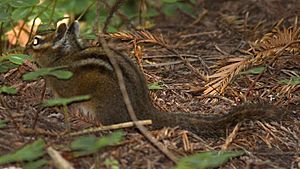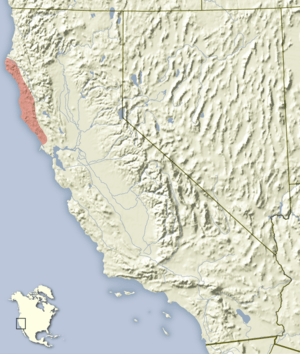Yellow-cheeked chipmunk facts for kids
Quick facts for kids Yellow-cheeked chipmunk |
|
|---|---|
 |
|
| Conservation status | |
| Scientific classification | |
| Genus: |
Neotamias
|
| Species: |
ochrogenys
|
| Synonyms | |
|
Tamias ochrogenys |
|
The yellow-cheeked chipmunk (Neotamias ochrogenys) is also known as the redwood chipmunk. It is a type of rodent in the squirrel family, called Sciuridae. This chipmunk lives only in areas near the coast of northern California in the United States. It makes its home in coastal forests with cone-bearing trees.
Contents
What Does It Look Like?
The yellow-cheeked chipmunk is the biggest chipmunk in its group, Neotamias. It grows to be about 23 to 30 centimeters (9 to 12 inches) long. This includes its tail, which is about 10 to 13 centimeters (4 to 5 inches) long.
This chipmunk is a dark, brownish-olive color. It has five dark stripes running along its body. The stripe down its back is the clearest. It also has three stripes on its head. A dark stripe goes across its eye, with lighter stripes on each side. There is a light patch of fur right behind its ear.
The sides of its body are a yellowish-brown color. This color slowly fades to a lighter shade on its belly. The fur on its belly is dark gray with white tips. Its bushy tail is flat from top to bottom. The top of the tail is the same color as its body. The underside is reddish-brown to orange. The hairs on its tail also have white tips.
In the fall, the chipmunk sheds its fur. Its winter fur is not as bright. It is also longer and feels softer.
Where Does It Live?
The yellow-cheeked chipmunk lives only along the coast of northern California. It lives in a narrow strip of land, never wider than about 40 kilometers (25 miles).
Its home range starts a few kilometers north of Bodega Bay and Freestone. These places are in Sonoma County. Its range goes north to the Eel River in Humboldt County. It can be found at heights up to 1,280 meters (4,200 feet). It prefers the damp coastal forests where there are many shrubs and bushes.
How Does It Behave?
The yellow-cheeked chipmunk is quite shy. People rarely see it. However, you can often hear its special call. It makes a sharp, two-part "chuck-chuck" sound. This sound is lower in pitch than the calls of other chipmunks. It sounds most like the call of Townsend's chipmunk (Neotamias townsendii). The chipmunk repeats this call regularly.
What Does It Eat?
The yellow-cheeked chipmunk eats seeds and fruits from many different plants. Scientists have found grass seeds in its cheek pouches. This means it might store food to eat later.
Early in the year, it eats fungi. It also eats acorns from oak trees and seeds from stoneseed plants for a long time each year. Sometimes, insect wings have been found in its stomach. This suggests it might also eat some animal food.
Is It Endangered?
The yellow-cheeked chipmunk lives in a small area. Its total living space is only about 20,000 square kilometers (7,700 square miles). However, the number of these chipmunks is stable. It does not face any major threats right now.
Because of this, the International Union for Conservation of Nature (IUCN) says it is of "least concern". This means it is not considered endangered.
See also
 In Spanish: Neotamias ochrogenys para niños
In Spanish: Neotamias ochrogenys para niños



